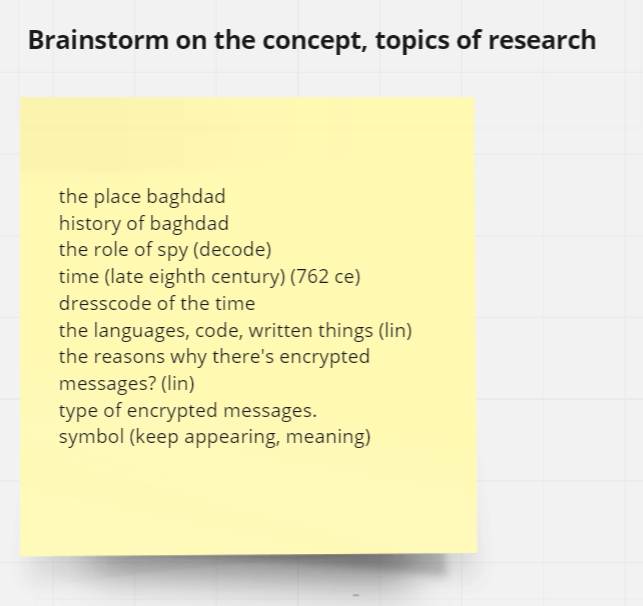DESIGN PRINCIPLES - WEEK 4
REPETITION AND MOVEMENT
Lecture
The two titular concepts were covered this week. Techniques were introduced such as using elements to draw a path to the main subject, not only through the shape of the elements but colours as well. Repetition served the purpose of empowering the design by familiarizing the eye with the design that is shown.
Visual Research
When looking for examples of movement, much of the reference materials did involve the use of curves to accentuate the movement of the subject. One prominent example is The Great Wave Off Kanagawa by Katsushika Hokusai, the use of large curves to direct the viewers gaze to the small boats (which were the main focus of the print) was very well utilized as the small "hooks" created by the sea foam also creates a sense of non-uniform movement.
(Fig 01, The Great Wave Off Kanagawa, Katsushika Hokusai, 1831)
When researching repetition, I found there were a lot less examples of this concept in a classical setting. However, many repetitive designs that are in use today are largely seen in mass produced mediums. Things such as wallpapers, carpets or even lingerie make use of repetitive design, perhaps to help embolden the design.
Idea Exploration
For the piece regarding movement, I had some difficulty finding inspiration for how to compose an image that could stay visually appealing. Initially I grabbed at the air looking for inspiration at anime shows of the mecha genre, as these shows normally involve much high speed movement. In the end I decided against it as the details that I had to colour for the piece was unfeasible for the assigned deadline, as well as lacking the technical skill in watercolour.
The piece for repetition was fairly easy for me to think an idea for. I like having water as a recurring theme in art pieces that I produce. The dynamic motion that water is capable of as well as the symmetry of the water drop that I had done last week gave me an idea to reattempt producing the piece I submitted the previous week, but with watercolour as a medium.
Final Design Outcomes
(Fig 04, Movement 1st colour pass, 23/4/2021)
While mulling over the concept for movement, a lecturer from another lesson commented on a sketch that I made was reminiscent of the anime Attack on Titan. Then it struck me, that show had some of the most movement-intensive scenes I had seen before and therefore I fashioned a scene with the shows theme in mind.
(Fig 05, Movement 2nd colour pass, 23/4/2021)
In terms of playing around with watercolour, I actually found legitimate techniques for painting from a manga that I have read a few months ago titled Blue Period. For example, painting over a green coat of paint with a mixture of vermillion and white produced a lovely shade for skin. I also utilized the textured nature of the brushes in order to create a motion blue effect.
(Fig 06, Movement Final Image, 23/4/2021)
For the 2 hours of work that I put into the piece, I think it turned out fairly well. The colours may have been slightly low in terms of saturation but I guess it was to be expected with the colour bleeding nature of watercolour.
For repetition, I wanted to create a design of a natural occurrence in an unnatural way. I wanted to redo the mediocre work that I made for last weeks image for balance. Using a compass, I drew ripples in a symmetrical arrangement, but I intended to shade the image in a non-uniform way.
(Fig 07, Repetition Sketch, 23/4/2021)
With the watercolour, I used a much more restricted colour palette. Only using various shades of blue with a hint of yellow, I began to shade the ripples produced on the surface of the water. It was difficult to paint effects such as ambient occlusion and differentiate hard/soft shadows with the paint bleeding all over.
(Fig 08, Repetition 1st colour pass, 23/4/2021)
Final rendering was easier than the initial colouring. I used a dry brush in order to recreate the sharp glare produced from light reflecting off water. Applying this dry paint over a dried background made it much less of a hassle. I wondered if I would enjoy oil painting if this was the case.
(Fig 09, Repetition Final Image, 23/4/2021)
This piece had a lot less detail in comparison with the other picture that I had painted. I did like the colours that I used since my favourite colour is blue. Using water to control the shades of blue that was put out was something that I found easier to control as the piece progressed.
Reflection for the Week
Watercolour is a medium that I have not used for a good 4 years. It was difficult trying to regain a grasp on using a brush on paper, given that I hadn't taken painting all that seriously before either. However using techniques that I applied while painting digitally also gave me a good sense of colours, and I could roughly tell how to create a given colour with what I had on hand. I had quite an enjoyable time creating these pieces and inspiration came from the most unexpected of places.
Sources:
Fig 03: https://www.istockphoto.com/vector/abstract-repetitive-pattern-design-gm1195570903-340814555










Comments
Post a Comment